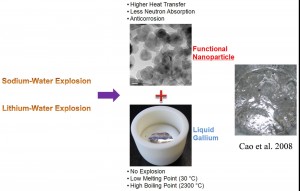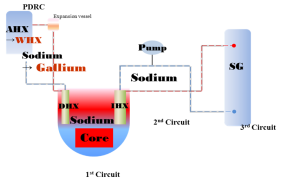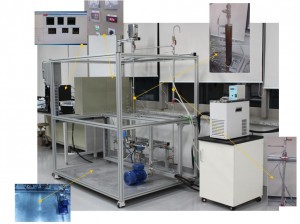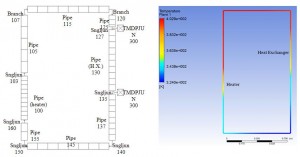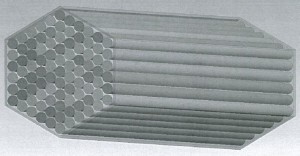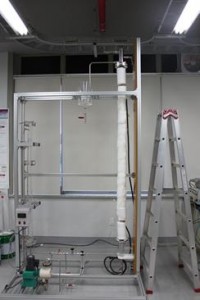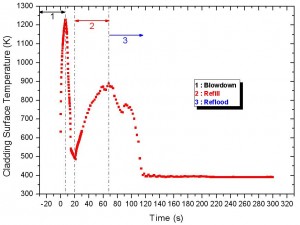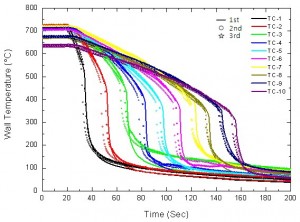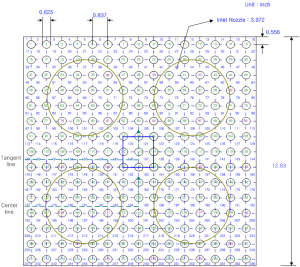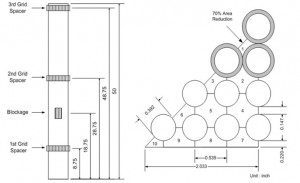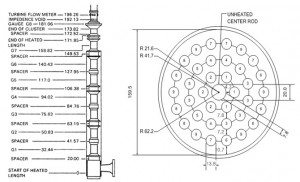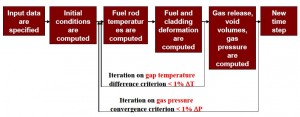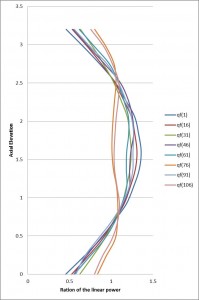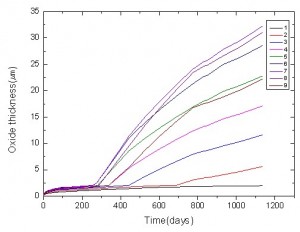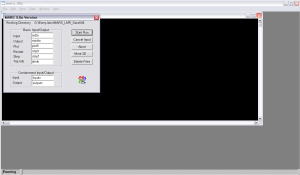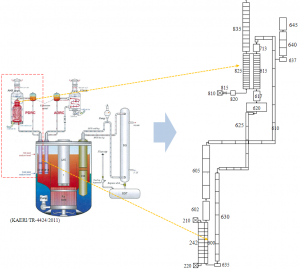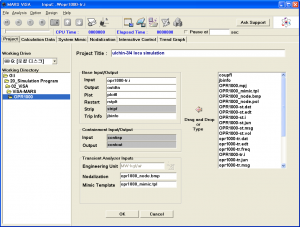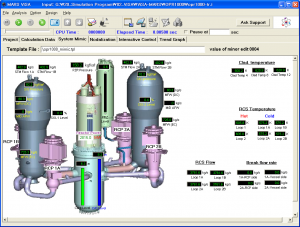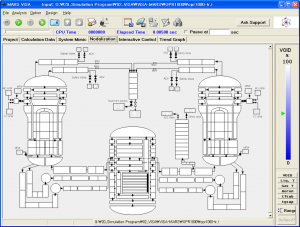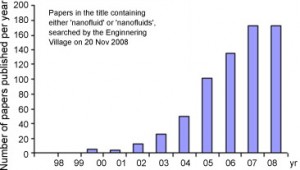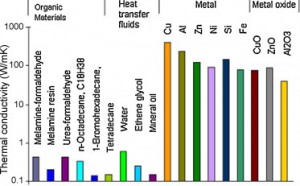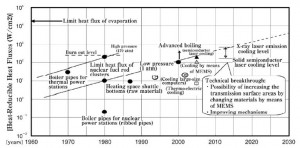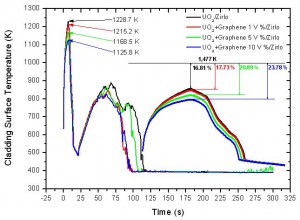Project
Safety and economic feasibility
After the Fukushima accident, the concerns on nuclear safety are increasing more than ever before. In particular, promising coolants for fast neutron reactors start to become major targets to the nuclear safety issues. Liquid metals such as sodium, sodium–potassium, lead, and lead–bismuth, as well as gallium have been considered as potential coolants in fast reactors. Among them, gallium is in the liquid state even under room temperature, has the lowest melting point (∼30 °C) and has no explosive reaction with water. However, liquid gallium has a lower thermal conductivity than other liquid metals such as sodium. If nanoparticles were evenly dispersed in liquid gallium, having the higher conductivity the suspended nanoparticles would be expected to produce a highly thermal-conductive coolant for nuclear applications without any safety concerns. At least, it would be promising to adopt the coolant in a safety system like passive decay heat removal system. The present work investigates the feasibility of using liquid gallium with nanoparticles in nuclear applications. The key issue of the original idea is whether a stable dispersion can be achieved with various nanoparticles having high thermal conductivities. In the study, the results show that good dispersion stability can be obtained by controlling shear rates based on centrifugal forces.
(a) Al2O3/liquid gallium mixture, (b) Al2O3/liquid gallium nanofluid, (c) SiC/liquid gallium mixture, (d) SiC/liquid gallium nanofluid, (e) TOF-SIMS analysis of Al2O3/liquid gallium nanofluid, and (f) TOF-SIMS analysis of SiC/liquid gallium nanofluid
Ga-cooled Passive Decay Heat Removal System
- Preliminary Concept of Advanced passive decay heat removal system (PDHRS) using gallium for SFR
The attractive properties ensure that gallium can play an important role in nuclear safety as an alternative coolant of the decay heat removal system of the SFR. In particular, there is an emphasis to passive safety system in nuclear reactor design so that reactors can be made more tolerant of failing, and have less dependence on engineers. The passive safety natural convection systems for decay heat removal have several benefits such as simplicity, reduction of the cost and usage problems of pumps. They are contributed to set the power plant in a safe and stable condition. Therefore, this study aims to experimentally investigate the natural convection capability of gallium as a feasibility study for the development of gallium-based passive safety features.
- Thermal-hydraulic analysis of a single-phase natural convection loop for liquid metal with MARS-LMR and computational fluid dynamics
This work discusses the results by using MARS-LMR code having Ga property table and computational fluid dynamics for the comparison of the heat transfer characteristics gained in experiments carried out in a single-phase natural convection loop. The loop consists of a vertical heating and cooling section and working fluid is liquid gallium. The experiment shows the natural convection capability of gallium by determining a flowrate formed according to a level of the heat input. By using the dimensionless numbers, the correlations in the tube at natural convection of gallium also are represented. This study can contribute to an advanced design of passive decay heat removal system with adopting a safer coolant to secure the safety more tightly of the current typical designs of sodium-cooled reactor.
Test facility
Nodalization and computational fluid dynamics analysis of test facility
8. Design and Development of safety analysis code for ultra long-life core reactor (UCFR)
3D view of one assembly of UCFR
For analysis of thermal hydraulic safety aspect, MATRA-LMR and SLTHEN code are used. MATRA-LMR (Multichannel Analyzer for steady-state and Transient in Rod Array for Liquid Metal Reactor) was developed as a subchannel analysis code to calculate the thermal-hydraulic characteristic of liquid metal reactors such as fuel, cladding, and coolant temperatures. With this code, the specific major parameters can be obtained and analyzed with other reactor to confirm the safety of the reactor.
SLTHEN (Steady-State LMR core Thermal-Hydraulic Analysis code based on Energy Model) is also analysis code which analyze the safety margin of the reactor. This code can evaluate the whole assemblies of nuclear core with considering peaking factor of each assembly and interaction with assemblies. In this lab, we used these codes to evaluate the concept of Ultra-long Cycle Fast Reactor (UCFR) which has been developed in UNIST.
In our lab, we design the secondary or third system which produces the electricity in nuclear power plant. Different types of turbine system (steam turbine, helium turbine, S-CO2 turbine) are studied and evaluated which could be the appropriate system for the new concept of reactor like UCFR. Using the software, we can optimize the system and get the good efficiency.
Example design of the third system of UCFR
- UCFR (Ultra-long-life Core Fast Reactor)
The concept for UCFR is designed to be operating at higher temperature and neutron dose than other liquid metal-cooled fast reactors and the refueling time is at least 30 years.
Because of longer refueling time, a large amount of fission gas is expected to be built up inside of the cladding. Therefore, internal pressure is increasing because of produced fission gas.
The fuel rod of UCFR must be designed to control the pressure generated by released fission gas. Thus several alternative concepts are being considered for UCFR design.
– Fission Gas Release
There are three means available to accommodate the fission gas:
- Allow additional volume within the fuel rod so that the allowable pressure is not exceeded.
- Remove the fission gas to a plenum external from the fuel rod:
It requires a means for transferring gas from the rod to the external plenum. If the external plenum was located apart from the fuel assembly, small tubes would be needed to connect the rods and the plenum. It would greatly clutter the interior of the pressure vessel.
- Vent the fission gas directly to the coolant
6. Development of heat transfer enhancement technique for high-power density nuclear fuel
For every engineering area, it is very important to increase the way of heat transfer to get high power levels with low cost. Especially in nuclear engineering, the design of fuel rod in nuclear core which can produce very high level power density is very important to run the nuclear plant with safety and economically. Therefore, understanding basic phenomenon of heat transfer is the main study to increase the efficiency; boiling heat transfer, flow visualization, temperature distribution, and nanofluids.
Flow visualization of nucleate boiling is important in many engineering fields because boiling mechanism can affect the safety margin of systems including nuclear power plants. Nucleate boiling is an effective method of heat transfer. However, nucleate boiling heat transfer is an empirical science which has not been justified for decades. So it is very important to measure the nucleate boiling phenomenon to approach the principle of bubbles’ formation.
Understanding of temperature distribution during heat transfer is the key phenomenon to remove the heat effectively because we can analyze the area where the maximum heat is distributed. LIF (Laser Induced Fluorescence) and IR thermometry are used as techniques for analyzing temperature distribution.
Nanofluids are used to increase thermal conductivity to increase thermal margin of reactor. Different nanofluids have been studied with different experimental equipment; wire pool boiling, plate pool boiling, and flow boiling. In our lab, we try to understand and research the reason how the thermal properties of nanofluids are increased compared with base fluids.
IR images of heater surface (plate pool boiling) during CHF experiment using FC-72
 LIF experiment with 1/40 scaled down Calandria Vessel (PHWR)
LIF experiment with 1/40 scaled down Calandria Vessel (PHWR)
5. Development of innovative safety system for nuclear power plant and severe accident management strategy
Wall temperature variation during water reflood
In a nuclear reactor system, the emergency core cooling system (ECCS) provides backup to the cooling system for prevent the melt of core and fuel assembly especially at the Loss of coolant accident (LOCA). In this state as like LOCA, firstly blowdwon occurred in the reactor core after that control rod is inject to the core for shutdown for core. But decay heat emitted in fuel assembly it is 6% of operating power. It can be cooled by injected coolant by the reflooding. If it doesn’t rapidly removed by coolant, nuclear fuel can be melted by high temperature and exposed by fission gas.
Injected water interacts with heated wall. In this situation, reflood shows phase change. We investigate reflood state with phenomenon. Furthermore, we research the enhanced coolant by using nanofluid. Enhanced coolant can be adopted for coolant for ECCS. It can useful to increase of operation time in the accident.
Facility of reflood experiment
Cladding surface temperature during LOCA
Wall temperature variation during water reflood
4. Design of safety system and safety assessment using system analysis code for nuclear power plant
원자력 발전소 안전성 향상을 위해서는 이와 관련된 해석코드의 수행이 필수적이다. 이러한 해석코드의 수행은 핵연료의 국부적인 부분에서 시작하여 피복재, 원자로 노심, 발전소 컴포넌트뿐 아니라 전체 계통에 대해서 이루어 진다. 이러한 연구를 수행하기 위해서 MATRA, FRAPCONE, MARS, PRISM, VISA, ANSYS 등 의 설계 해석코드들이 이용된다.
MATRA
The reactor core including coolant, control and protection systems should be designed with appropriate margin to assure that SAFDL (Specified Acceptable Fuel Design Limits) are not exceeded during any condition of normal operation, including the effect of anticipated operational occurrences. The SFADL includes cladding overheating due to CHF or hydrodynamic flow instability and fuel melting. Therefore, the object of core thermal hydraulic design is to make sure coolability and fuel thermal integrity in the core during steady-state and anticipated operational occurrences. To do this, MATRA (Mutichannel Analyzer for steady-state and Transient in Rod Arrays) is studied for analyzing subchannel of the nuclear reactor. In PWR, CHF (Critical Heat Flux), fuel melting, and flow instability are the main thermal hydraulic design criteria. By using MATRA, the prediction of CHF is possible and other major parameters can be obtained.
FRAPCON
FRAPCON is one of the computational analysis code. It specially analyzes the fuel performance. The FRAPCON code had been developed to predict the behavior of fuel rods during long-term irradiation and to calculate initial conditions for transient analysis by combining features from “FRAP(Fuel Rod Analysis Program)” and “GAPCON(GAP CONductance)-THERMAL”. Recently updated FRAPCON code calculates the steady-state response of light water reactor fuel rods during long-term burnup.
The Scopes of FRAPCON are as follows:
- Heat conduction through the fuel and cladding
- Cladding elastic and plastic deformation,
- Fuel-cladding mechanical interaction
- Fission gas release
- Fuel rod internal gas pressure
- Heat transfer between fuel and cladding
- Cladding oxidation
- Heat transfer from cladding to coolant
Simplified FRAPCON-3 Flow Chart
(Ref. NUREG/CR-6534 Vol. 2 PNNL-11513)
Power ratio at each step
MARS-LMR
MARS-LMR (Multi-dimensional Analysis Reactor System for Liquid Metal Reactor)
MARS-LMR is a safety analysis code for the safety function evaluation of system as SFR. This safety analysis code uses the coolants of future reactors such as sodium, lead-bismuth eutectic, helium, lithium, lithium-lead and so on. To analyze the future reactors, it has to generate the set of physical properties and thermodynamic tables of MARS code and those of Na, LBE are already generated by KAERI. Our lab also generated that of Gallium and is analyzing Ga-cooled PDHRS (Passive Decay Heat Removal System) is SFR.
Nodalization of Ga-cooled PDHRS in KALIMER
VISA
ViSA is the Visual System Analyzer. ViSA is external environment program for MARS, RETRAN, RELAP5 and the programming language of ViSA is Delphi. The main features of ViSA are as follows:
- Online & post processing: X-Y trend graph vs. time
- Visualization of entire system behavior: System mimic with several gauges & Nodalization map for volume properties (boron, void, liquid/gas temperature,..)
- Interactive control : Simplifying control input for complex manual operation in EOP
- Miscellaneous functions : Control / Geometric input editor for modification & Replay (similar to strip function in MARS), 3-D power visualization (MASTER DLL required), Engineering unit conversion
Project tab of ViSA (OPR-1000)
System mimic tab of ViSA (OPR-1000)
Nodalization tab of ViSA (OPR-1000)
CFD
Computational fluid dynamics, usually abbreviated as CFD, is a branch of fluid mechanics that uses numerical methods and algorithms to solve and analyze problems that involve fluid flows. Computers are used to perform the calculations required to simulate the interaction of liquids and gases with surfaces defined by boundary conditions. With high-speed supercomputers, better solutions can be achieved. Ongoing research yields software that improves the accuracy and speed of complex simulation scenarios such as transonic or turbulent flows.
Computational Fluid Dynamics (CFD) is increasingly being used in nuclear reactor safety analyses as a tool that enables safety relevant phenomena occurring in the reactor coolant system to be described in more detail. Numerical investigations on single phase coolant mixing in Pressurized Water Reactors (PWR) have been performed. The work is aimed at describing the mixing phenomena relevant for both safety analysis, particularly in steam line break and boron dilution scenarios, and mixing phenomena of interest for economical operation and the structural integrity.
3. Heat transfer enhancement technique using nanofluid for coolant in nuclear applications
A variety of Generation III/III+ water-cooled reactor designs featuring enhanced safety and improved economics are being proposed by nuclear power industries around the world in efforts to solve the future energy supply shortfall. Thermal-hydraulics is recognized as a key scientific subject in the development of innovative reactor systems. Applications are being advanced with the introduction of new technologies such as nanotechnology. Nanofluids are potential heat transfer fluids with enhanced thermophysical properties and heat transfer performance can be applied in many devices for better performances. Recent researches have indicated that substitution of conventional coolants by nanofluids appears promising. Specific application of nanofluids in engine cooling, solar water heating, cooling of electronics, cooling of transformer oil, improving diesel generator efficiency, cooling of heat exchanging devices, improving heat transfer efficiency of chillers, domestic refrigerator-freezers, cooling in machining, in nuclear reactor and defense and space have been applied.
The development of viable nanofluids for use in water-cooled nuclear systems could result in a significant improvement of their economic performance and/or safety margins. Especially, it was determined that the system has a reasonably low failure probability, and that, once injected, the nanofluid would be delivered effectively to the reactor vessel surface within seconds. It was also shown analytically that the increase in decay power removal through the vessel using a nanofluid is about 40%, which could be exploited to provide higher in-vessel retention (IVR) safety margin or, for a given margin, to enable IVR at higher core power.
Fig. 3-1 Growth of publications by the nanofluids community
Fig. 3-2 Comparison of the thermal conductivity of common liquids, polymers, and solids
Fig. 3-3 Required heat removal capacity
Recently undesired Axial Offset Anomaly (AOA) was issued in the nuclear industry. AOA referring to an unexpected neutron flux depression is also known as Crud Induced Power Shift (CIPS). It was occurred by boron which is injected to controlling power level in the core but unfortunately boron working neutron absorber deposited on the fuel surface. Fuel assemblies removed from an AOA core has shown a thick porous deposition layer of crud on fuel clad surface. The deposition layer was induced by precipitation reactions of both boron species and crud during sub-cooled nucleate boiling.
“CRUD” is an abbreviating for “Chalk river unidentified deposition”. Combination of product as corrosion and oxidation material deposited in the core and it shows porous structure. For many researchers investigate the crud to characterize the composition for controlling operation. However, it has various characteristic because of environment characteristic. So it is difficult to decontamination.
CRUD removal system was recently developed as like ultrasonic mechanism. Ultrasonic mechanisms are developed but it has limitation for decontamination, therefor we investigate the other method as like hydrodynamic cavitation. Collapse of cavitation make the high shock pressure it can be helpful for decontamination.
For using the cavitation, firstly we investigate the cavitation effect as like magnitude of shock pressure.
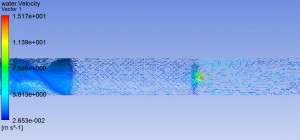
Fig. 2-1 Vector of water velocity
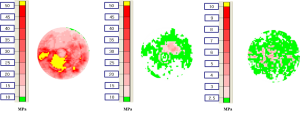
Fig. 2-2 Effect of cavitation in case of using the sensitive film for investigating shock pressure
The commercial nuclear power industry is interested in advanced fuels that can produce higher power levels with a higher safety margin and be manufactured at low cost. Requirements of advanced fuels are as follows: high thermal conductivity, chemical stability (low reactivity with water) and low manufacturing cost. Although UO2 fuel is chemically stable, its thermal conductivity is low. In the nuclear engineering field, the thermal conductivity of fuels is a very important parameter for the optimum design and safety analysis of a nuclear system. This is because the thermal conductivity of fuels significantly affects the internal energy of the nuclear fuel by heat transfer through the coolant. Therefore, the safety analysis using fuel thermal conductivity is necessary for the prediction of thermal-hydraulic behavior. If graphene is mixed in UO2 fuel, it is chemically stable and its thermal conductivity will be enhanced. The benefits increased monotonically with increasing thermal conductivity in terms of reduced radial fuel rod temperature and peak cladding temperature (PCT). It is confirmed that the UO2/graphene composite fuel can lower the radial fuel rod temperature and peak cladding temperature during LBLOCA (Large Break Loss of Coolant Accident) through the MARS-KS (Multi-dimensional Analysis of Reactor Safety-Korean Standard) code.
Fig. 1-1 Radial fuel rod temperature according to volume fraction of UO2/Graphene composite fuel when the cladding material is Zirlo
Fig. 1-2 Cladding surface temperature according to volume fraction of UO2/Graphene when the cladding material is Zirlo



